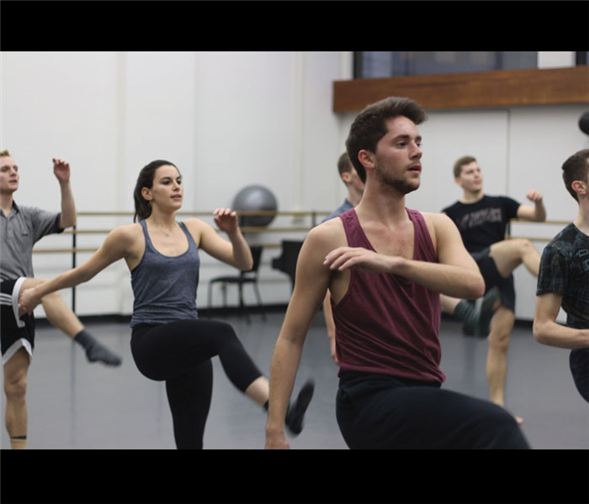Translate Page

The radical scope of Juilliard's New Dances program
---
It's not every day that you come across a dance program sporting four world premieres. Or one that features a cast of 94 dancers. But that is the exciting promise of Juilliard's annual New Dances program, which puts a premium on creativity and exploration.
For the past two months, Juilliard's third-floor dance studios have been bustling with enthusiastic collaboration. Four established choreographers, all of whom have their own companies, have been in adjacent studios, each making a work for one of the four Juilliard Dance Division classes. (This year's program runs December 11-15).
Just before Thanksgiving, Zvi Gotheiner was observing the 23 third-year students tackling his nearly-completed dance, which is set to six selections from Nino Rota's film scores. Next door, Helen Simoneau was asking the 24 first-year students to show her "the swirl" -- a section of her Strange Garden where the huge mass of dancers navigate through twisty positions on the floor. Meanwhile, the senior class was rehearsing Kyle Abraham's non sequitur paramour and Aszure Barton was casting her watchful eye over the 24 second-year students as they tried out a slow, lunging walk, then peeled off from a line stage right into a series of fluid, hypnotic solos.
While New Dances is stimulating for audiences, it also provides a challenge and opportunity for the choreographers, who covet these commissions – the chance to create on a large, talented ensemble and show their dances in Juilliard's elegant and well-equipped Peter Jay Sharp Theater.
Of course, Juilliard is an educational institution, and when Lawrence Rhodes envisioned the project soon after arriving as director of the the school's Dance Division in 2002, he aimed to rectify unmet needs. Before he shook up the curriculum and performance schedule, the Juilliard dancers performed only once a year, in a major repertory concert each February – and rehearsed for months just for that.
"That way, there were a lot of students left out of performance opportunities," he says. "They auditioned for the works to be performed in February, and those who weren't cast never got to perform." He went to Juilliard president Joseph Polisi with a proposal. "I said, 'I think this isn't a good idea, and that performance is part of training. I want to start a new program that guarantees that every dancer would have involvement with a professional choreographer every year, and that every dancer would perform on the big stage at least once a year.' I wanted to make sure that they all were having these opportunities."
New Dances was launched in 2003, and it has since become a vibrant December tradition. Rhodes casts a wide net, in terms of the choreographers' aesthetics, style, and experience. In essence, he has been creating a repertory – about four dozen new dances have been unveiled, with several going on to the Fall for Dance Festival or in performances with Juilliard dancers sharing the stage with the choreographers' own companies.
"I'm looking for someone who shows me, in one way or another, that they know how to control space and how to use space," says Rhodes, who seems to attend every dance event in the city and has numerous friends and contacts from his years as a dancer and company artistic director.
He'd wanted Abraham to be part of New Dances for a few years, and the scheduling finally worked out. Meanwhile, Simoneau, a Quebec native and the youngest of the four, freely admits she pursued this opportunity. "I have to say that I'd been chasing him," she says with a laugh, shortly before going into her rehearsal. "I'd been sending him video of every work and inviting him to any New York performances I had. After he came to my company's BAM Fisher performance, we started a conversation."
{Image1}
And why such eagerness to be selected for New Dances? "It's a great opportunity, in multiple ways," Simoneau says. "A choreographer like me doesn't get to work with 24 dancers. It's intimidating, but it's exciting because it's a whole different set of skills. There certainly are moments where I'm focusing a lot on individual performances, but there's something really exciting and different. My company has six people, so it's a lot about relationships. But when you have 24, it's a whole different challenge. Shaping the stage becomes a really fun part of it, because you have enough people to really do that – and a large stage."
Simoneau is collaborating with composer Jerome Begin, whose original score will be performed live, as will Caroline Shaw's piano score (which "wraps around" a Chopin mazurka) for Barton's return to patience.
Gotheiner, who was also chosen for the inaugural year of New Dances, had known for a while he wanted to use Rota's music, familiar from many Fellini films. He'd been waiting for the right occasion. "After watching this class in two technique classes last spring, that music came back to mind. I thought it would give me – and maybe them – an opportunity to find the fun and pleasure of this music. I felt like this music will match my image of this class."
He considers the chance to be part of New Dances "an amazing opportunity," and he's duly impressed by the Dance Division, which was recently honored with the prestigious Capezio Award. "The level of talent that you work with is just amazing. They become sophisticated dancers at such an early age, with great enthusiasm and willingness for an experience. It seems they're having fun with one another, and it's intoxicating."
---
Susan Reiter regularly covers dance for TDF Stages.
Photos by Jessica Liese. Top photo: Third-year students Conner Bormann, Katherine Garcia, and Casey Hess.
TDF Members: Browse our discounts for dance, theatre, and concerts.